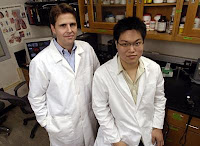Coated nanoparticles solve sticky drug-delivery problem, Researchers take cues from viruses to get treatment through body's protective. PODCAST FOR THIS ARTICLE.
 | The layers of mucus that protect sensitive tissue throughout the body have an undesirable side effect: they can also keep helpful medications away. To overcome this hurdle, |
During experiments with these coated particles, the researchers also discovered that mucus layers have much larger pores than previously thought, providing a doorway that should allow larger and longer-acting doses of medicine to reach the protected tissue.
The team's findings were reported this week in the Early Online Edition of Proceedings of the National Academy of Sciences.
"Mucus barriers evolved to serve a helpful purpose: to keep things out," said Justin Hanes, an associate professor of chemical and biomolecular engineering who supervised the research. "But if you want to deliver medicine in a microscopic particle, they can also keep the drugs from getting through. We've found a way to keep helpful nanoparticles from sticking to mucus, and we learned that the openings in the mucus 'mesh' are much larger than most people expected. These findings set the stage for a new generation of nanomedicines that can be delivered directly to the affected areas."
To get its particles past the mucus, Hanes' team studied an unlikely model: viruses. Earlier research led by Richard Cone, a professor in the Department of Biophysics at Johns Hopkins, had established that some viruses are able to make their way through the human mucus barrier. Hanes and his colleagues decided to look for a chemical coating that might mimic the characteristics of a virus.
"We found that the viruses that got through had surfaces that were attracted to water, and they had a net neutral electrical charge," said Samuel K. Lai, a Johns Hopkins chemical and biomolecular engineering doctoral student from Canada and Hong Kong who was lead author of the journal article. "We thought that if we could coat a drug-delivery nanoparticle with a chemical that had these characteristics, it might not get stuck in the mucus barrier."
To make their nanoparticles behave like viruses, the researchers coated them with polyethylene glycol, PEG, a non-toxic material commonly used in pharmaceuticals. PEG dissolves in water and is excreted harmlessly by the kidneys.
The researchers also considered the size of their nanoparticles. Previous studies indicated that even if nanoparticles did not stick to the mucus, they might have to be smaller than 55 nanometers wide to pass through the tiny openings in the human mucus mesh. (A human hair is roughly 80,000 nanometers wide.) Using high-resolution video microscopy and computer software, the researchers discovered that their PEG-coated 200-nanometer particles could slip through a barrier of human mucus.
They then conducted further tests to see how large their microscopic drug carriers could be before they got trapped in the mesh. Larger nanoparticles are more desirable because they can release greater amounts of medicine over a longer period of time. "We wanted to make the particles as large as possible," said Hanes, who also serves as director of therapeutics for the Institute for NanoBioTechnology at Johns Hopkins. "The shocking thing was how fast the particles that were 500 nanometers wide moved through the mucus mesh. The work suggests that the openings in the mucus barrier are much larger than originally expected by most. And we were also surprised to find that the larger nanoparticles (200 and 500 nanometers wide) actually moved through the mucus layer more quickly than the smaller ones (100 nanometers wide)."
This has important implications, Hanes said, because a 500-nanometer particle can be used to deliver medicine to a targeted area, released over periods of days to weeks. Larger particles also allow a wider array of drug molecules to be efficiently encapsulated. He and his colleagues believe this system has great potential in the delivery of chemotherapy, antibiotics, nucleic acids and other treatment directly to the lungs, gastrointestinal tract and cervicovaginal tract. ###
Through Johns Hopkins Technology Transfer, the team has applied for patents covering this process.
In addition to Lai, Hanes and Cone, co-authors of the PNAS paper included D. Elizabeth O'Hanlon and Suzanne Harrold, doctoral students in the Johns Hopkins Department of Biophysics in the Krieger School of Arts and Sciences; Stan T. Man, a former visiting research scientist in the Johns Hopkins Department of Chemical and Biomolecular Engineering in the Whiting School of Engineering; and Ying-Ying Wang, who contributed to the research as a Johns Hopkins undergraduate and who is now a graduate student in the university's Department of Biomedical Engineering.
Lai's participation was partially supported by a scholarship from the Natural Science and Engineering Research Council of Canada.
Digital photos of the researchers available; contact Phil Sneiderman.
Contact: Phil Sneiderman prs@jhu.edu 443-287-9960 Johns Hopkins University
Related Links: Justin Hanes' Lab Page: jhu.edu/~cheme/hanes/ Department of Chemical and Biomolecular Engineering: jhu.edu/chbe/ Richard Cone's Lab Page: biophysics.jhu.edu/cone/ Institute for NanoBioTechnology ay Johns Hopkins: inbt.jhu.edu/
Technorati Tags: nanofibers or Nanoscientists and Nano or Nanotechnology and nanoparticles or Nanotech and nanotubes or nanochemistry and nanoscale or nanowires and Nanocantilevers or nanometrology and nanostructure or chemical and biomolecular engineering and Department of Biophysics at Johns Hopkins or NanoBioTechnology















No comments:
Post a Comment